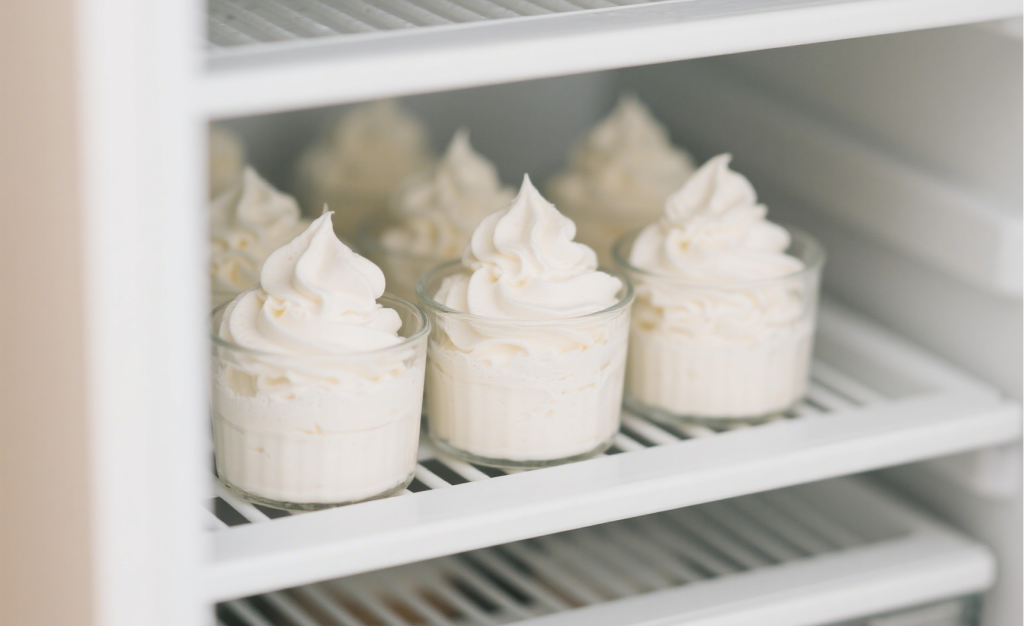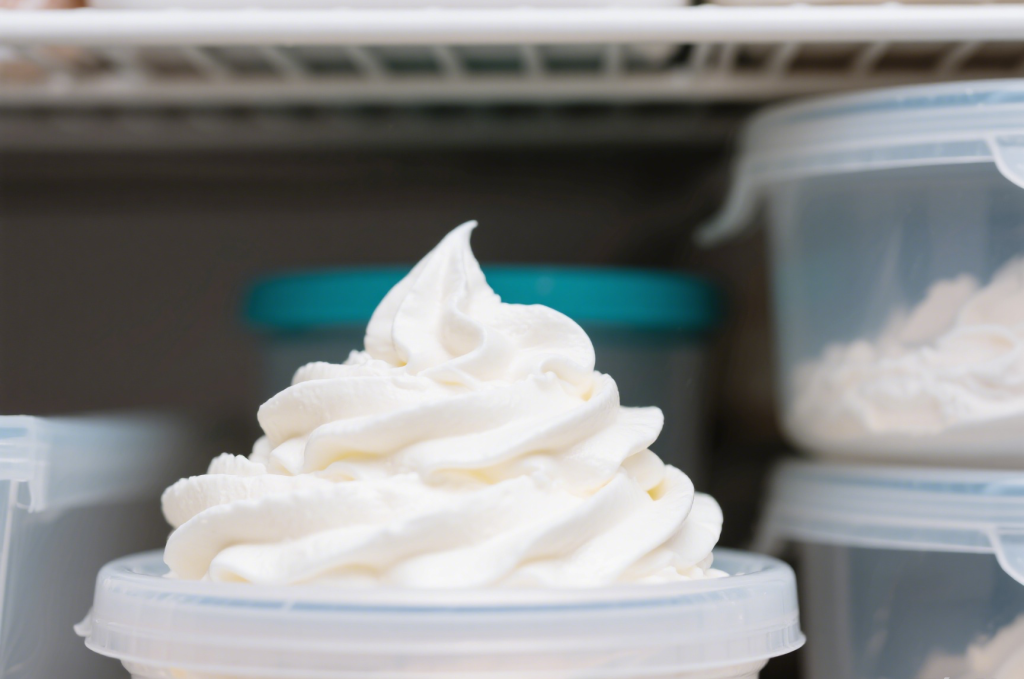Whipped cream, known for its airy texture and rich dairy flavor, is the “universal supporting actor” in the baking world. However, this delicate delight is like a “cream princess”—extremely sensitive to its storage environment. Improper storage not only causes it to lose its elegant fluffiness but can also pose food safety risks. This article will explore the science, storage methods, common mistakes, and innovative tips to help you become a true “guardian” of whipped cream.
When storing whipped cream, avoid temperature fluctuations and air exposure. Homemade whipped cream should be sealed and refrigerated at 2–4°C, and consumed within 24–48 hours. Store-bought cream should also be refrigerated once opened: spray cream lasts 2–3 weeks, and boxed cream should be used within 7–10 days. When freezing, portion it out to prevent texture damage caused by ice crystals, and avoid hot and humid environments to prevent bacterial growth and flavor degradation.
Let’s dive in for a detailed understanding!

I. Why Is Proper Storage of Whipped Cream Important?
1. The Microcosm of Whipped Cream: Fat Globule Stability and Collapse
The fluffiness of whipped cream is essentially a “dance of fat globules.” As cream is whipped, mechanical movement ruptures milk fat globules, allowing released fat molecules to intertwine, forming a mesh structure that traps air and water, resulting in a fine foam system. The stability of this structure depends on the integrity of fat globules, protein emulsification, and environmental conditions (temperature, humidity, air).
Threat of Fat Oxidation: When exposed to air, fat molecules oxidize with oxygen, producing aldehydes and ketones, resulting in rancidity.
Water-Oil Separation Crisis: High temperatures accelerate fat molecule movement, destroying the mesh and causing water to seep out. Excessive freezing causes ice to expand, piercing fat globules and forming a grainy texture after thawing.
2. Hidden Microbial Dangers
Whipped cream, rich in fat, protein, and water, is an ideal culture medium for microbes.
Bacterial Hotbed: At room temperature (20–30°C), harmful bacteria like E. coli and Salmonella can double every 20 minutes. If exposed to room temp for over 2 hours (or over 1 hour in high heat), bacterial colonies may exceed safe limits, causing food poisoning.
Mold Growth: Unsealed whipped cream may be contaminated by airborne mold spores, forming fuzzy colonies (e.g., penicillium, aspergillus) that produce toxins like aflatoxins—even if mold is removed, toxins can spread throughout.
3. Irreversible Sensory Damage
Three Stages of Texture Degradation:
- Initial: Surface drying, dullness due to water evaporation.
- Middle: Softening and collapse, water-oil separation.
- Final: Sour smell, yellowing due to oxidation and bacterial byproducts.
Flavor Contamination: Pungent foods like onions and garlic in the fridge can release volatile compounds that are absorbed by whipped cream, resulting in bizarre flavors.
II. How Long Does Whipped Cream Last?
1. Homemade Whipped Cream
Basic formula (e.g., 200ml heavy cream):
Pure Cream (No Stabilizer):
- Shelf Life: 24–48 hours in sealed container at 4°C, best taste within 6 hours.
- Scientific Basis: Without stabilizers, fat globules are only stabilized by native milk proteins. Over time, protein repulsion weakens, causing coalescence.
With Stabilizers:
- Cornstarch Method: Mix 1g cornstarch with 10ml cold milk, heat into a paste, cool, and whip with cream. Extends life to 3–4 days.
- Gelatin Method: Soften 5g gelatin in cold water, dissolve in warm water, mix with 15ml warm cream, then fold into whipped cream. Lasts 4–5 days.
- Powdered Sugar Method: Add 8–10g powdered sugar (or 2g vanilla sugar) per 100g cream. Sugar binds moisture and increases viscosity, delaying collapse.
2. Store-Bought Whipped Cream
Spray Cream (e.g., Reddi-wip):
- Unopened Shelf Life: 12–18 months at room temp (N₂O inhibits microbes and prevents water activity).
- After Opening:Store upright at 4°C for 2–3 weeks. Tilting causes gas to escape and cream to liquefy.To unclog nozzle: rinse with warm water (40–50°C) for 30 seconds to melt hardened fat.
Boxed Liquid Cream (e.g., Blue Windmill, Anchor):
- Unopened Refrigerated: 1–2 months (pasteurization kills pathogens).
- After Opening: lasts 7–10 days when whipped and refrigerated, better than homemade due to stable milk fat globule membranes and homogenization.
Non-Dairy Cream:
- Made from hydrogenated vegetable oils, with emulsifiers and stabilizers.
- Shelf Life: 10–14 days when whipped and refrigerated. More heat-resistant but may contain trans fats.
3. Spoilage Signs
- Visual: Normal = smooth glossy white with defined peaks. Spoiled = puddles, curds, gray tint.
- Smell: Normal = fresh and slightly sweet. Spoiled = sour, moldy, or plastic-like.
- Touch: Normal = smooth piping. Spoiled = sticky (bacterial polysaccharides) or grainy (ice damage).
III. How to Store Homemade Whipped Cream?
1. Container Choice
Seal is Key:
- Recommended: glazed ceramic or glass containers.
- Avoid: regular plastic (porous), paper (absorbs moisture).
Volume Fit: Use containers 1.5–2× the volume to avoid crushing foam.
Light Protection: Use dark glass or foil wrap to prevent UV-induced oxidation.
2. Temperature Control
Ideal Range: 2–4°C reduces bacteria growth by 90%, inhibits lipase by 80%.
Tips: Refrigerate within 15 mins of whipping. Use ice bath when whipping.
Freezing Tips:
- Small Batch Method:Use silicone trays (15ml per cube), pipe with 3cm nozzle onto parchment-lined tray, freeze for 4 hours, transfer to sealed bag (lasts 1 month at -18°C).Use directly in hot drinks or frozen desserts.
- Prevent Ice Crystals: Press cling wrap against cream surface before freezing.
3. Stabilizer Use
Cornstarch Formula:
For frosting: 500ml cream + 5g cornstarch + 50ml whole milk.
Cool paste to room temp before mixing to avoid structural damage.
Gelatin Timing:
Dissolve at 40–45°C. Mix when cream reaches soft peaks; whip 10 seconds to blend.
Arabic Gum Innovation:
0.5g per 100ml cream, dissolved in 10ml warm water. Yields texture like light cheesecake, great for mousse layers.

IV. How to Store Store-Bought Cream?
1. Spray Cream: The Art of Pressure Maintenance
Physics of Positioning:
- Store upright: gas remains at the top, maintains pressure.
- Tilted: gas mixes with cream, ejects a thin, watery stream.
- Worst Case: upside-down for 12+ hours blocks nozzle and lowers pressure.
Tips:
- Shake gently for 5 seconds after use to re-balance gases.
- Wrap nozzle with cling film and secure with rubber band to reduce leakage.
2. Boxed Cream: Secondary Preservation
Hygienic Pouring:
- Use long-spout pitcher to avoid contamination.
- Avoid scooping with spoon—hands may introduce bacteria.
Best Fridge Spot:
- Back of middle shelf (stable ±1°C).
- Avoid door shelves (±5°C fluctuation), vegetable drawer (humid).
3. Non-Dairy Cream: Special Considerations
Thawing:
- Never thaw at room temp—outer melts, center stays frozen.
- Best method: transfer from -18°C freezer to 4°C fridge 12 hours in advance.
Rewhipping:
If too soft after thawing, add 10% cold dairy cream to stabilize.
V. Common Mistakes That Ruin Whipped Cream
1. Time Misjudgment
“Just a Few Minutes” Myth:
At 25°C, bacterial count multiplies 5× per hour. After 30 mins at 30°C, counts can rise from 10³ CFU/g to 1.25×10⁵ CFU/g.
Solutions:
- Baking Parties: Use insulated box with ice pack.
- Picnics: Place cream in ice-filled cooler, cover with towel.
2. Inefficient Fridge Usage
| Fridge Area | Avg Temp (°C) | Best Storage For | Whipped Cream Risk |
| Top Door Shelf | 6–8°C | Ready-to-eat items | ★★★★☆ |
| Middle Drawer | 3–5°C | Dairy, meat | ★★☆☆☆ |
| Bottom Freezer | -18°C | Frozen goods | ★★★☆☆ |
Optimization: Use thermometers, dedicate a drawer with phase-change ice packs.
3. Hidden Seal Leaks
Seal Test:
- Water Test: Fill container with water, invert for 5 mins—check for leaks.
- Pressure Test: Press the lid—tight seal makes a “pop” sound.
Common Issues:
- Aged rubber seals (replace every 6 months).
- Deformed plastic locks (reinforce with food-grade silicone tape).
4. Unclean Tools
Sanitization Standards:
- Physical: Dishwasher at 70°C+ for 5 mins kills 99.9% bacteria.
- Chemical: Soak in 1:100 sodium hypochlorite for 10 mins, rinse until chlorine-free.
High-Risk Tools:
- Piping Nozzles: Use thin brushes to clean residue.
- Electric Mixer Parts: Clean axle joints with toothpicks—bacteria multiply 3× faster here.
5. Freezing Oversights
Ice Crystal Theory:
- Slow Freeze (-5°C): Large crystals >100μm damage fat globules.
- Flash Freeze (-25°C or lower): Microcrystals <10μm cause minimal damage.
Home Fixes:
- Pre-freeze trays for 1 hour before use.
- Freeze in small batches (≤⅓ tray volume) to avoid layering delays.
VI. Advanced Tips: The “Preservation Revolution” & Creative Uses
1. Vacuum Storage Across Domains
- Principle: Use vacuum pump to reduce oxygen to <0.1%, inhibiting oxidation and aerobic bacteria.
- DIY Method: Use vacuum boxes and handheld pump—extends homemade cream life to 5–7 days.
2. Sous Vide Preservation Experiment
- Method: Seal whipped cream in vacuum bag, sous vide at 60°C for 30 mins, then chill.
- Effect: Kills bacteria while retaining some lipase activity for “fermented cream” flavor. Shelf life: up to 10 days (texture altered, suitable for sauces not frosting).
3. Whipped Cream “Rescue” Techniques
Slight Collapse: Add 10% cold cream and rewhip at low speed.
Severe Separation:
- Fix: Add 10g unsalted butter to cream, heat to 40°C while stirring to re-emulsify. Chill and use as pasta or cake filling sauce.
- Creative Use: Add cocoa, caramel, etc., for a “deconstructed cream sauce” to pair with pound cake.
4. Eco-Friendly Storage Options
- Sustainable Materials: Bamboo fiber jars (antibacterial, 6-month biodegradation), sodium alginate gel bags (edible and melt into drinks).
- Cost Consideration: Higher initial cost than plastic, but reduces single-use waste—ideal for eco-conscious users.
VII.Conclusion
Storing whipped cream is not just a life skill—it’s a reflection of food respect and scientific mindfulness. From understanding molecular stability to tailoring storage by type, and even using modern technology to push the limits of freshness, every detail showcases the wisdom of a true “food steward.”
Want to learn more about whipped cream or buy cream chargers? Visit the Cream Buffet official website!